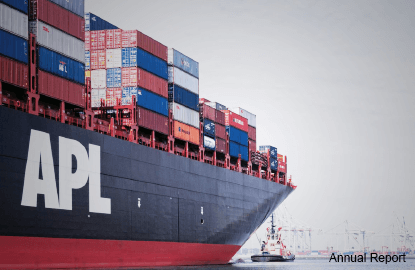
This article first appeared in The Edge Malaysia Weekly, on November 16 - November 22, 2015.
NEPTUNE Orient Lines Ltd (NOL), the biggest shipping group in Asean, is currently in talks with two interested parties to hive off its container shipping business.
Should the talks bear fruit, it will benefit either Westports Holdings Bhd or MMC Corp Bhd’s Pelabuhan Tanjung Pelepas (PTP).
Public-listed NOL last Saturday confirmed to Singapore Exchange (SGX) that it is in preliminary talks with two shipping giants — France’s CMA CGM S.A. and Denmark’s AP Moeller-Maersk Group — on a possible buyout.
It is worth noting that CMA CGM is the largest customer of Westports and Maersk Group owns a 30% stake in PTP through Maersk line. In fact, PTP is Maersk’s shipping hub in Southeast Asia.
Some quarters believe that should one of the Europe-based shipping giants take over NOL’s container business, it would help boost the throughput volume of the port it owns.
This is exactly what happened back in 2005 when Danish shipping group Maersk bought container line Royal P&O Nedlloyd.
After the acquisition, the container throughput at PTP surged to a record high of 2.24 million twenty-foot equivalent units (TEUs) in six months, thanks to the integration of Maersk & P&O Nedlloyd, which brought about new services.
Furthermore, an industry observer points out that the government has granted tariff hikes for the country’s ports. Hence, any increase in throughput volume will have an even bigger impact on the ports’ profits.
When contacted, Westports CEO Ruben Emir Gnanalingam declines to comment, saying that it is too early to talk about the possible deal and its impact.
“There are no details to draw any concrete conclusions. Therefore, any feedback now would be speculation, which we cannot participate in,” he adds.
PTP also declines to comment, saying that it needs to verify the information before replying to any media enquiries on the matter.
According to NOL’s filings with SGX, it transported 5.6 million TEUs worldwide last year. For the first nine months of this year, it handled 3.6 million TEUs, compared with four million TEUs in the previous corresponding period. The drop in throughput volume was mainly due to void sailings, absence of peak summer season and weak container trade demand.
Westports’ throughput volume was 8.4 million TEUs last year, up from 7.5 million in 2013. For the first half of this year, it handled 4.4 million TEUs. Some 7,000 container vessels docked at Westports last year, compared with 6,700 in 2013.
Over at PTP, the port operator handled 8.5 million TEUs in 2014, making it the largest port in the country, in terms of throughput volume. PTP aims to achieve a new record of 9.2 million containers this year.
In terms of earnings performance, NOL posted a net loss of US$96.1 million (RM418.1 million) in the three months ended Sept 30, 2015. Revenue fell to US$1.21 billion, due to lower liner revenue from void sailings, absence of peak summer season, weak container trade demand and the challenging freight rate environment.
The global economic slowdown is expected to hit the shipping industry again. Already, many big players have reportedly been forced to embark on cost-cutting measures like laying off workers. More players are looking at possible mergers and acquisitions to sustain growth.

Will history be repeated this time?
Although there is a precedent, analysts hold mixed views on the potential benefits of the proposed acquisition to Westports and PTP.
“Definitely there will be some positive impact on [the earnings of] Westports or PTP. But we are unclear how significant it would be,” says an analyst.
Theoretically, the analysts say if CMA CGM were to seal the deal, Westports would probably see a surge in throughput. And the same will happen to PTP if Maersk successfully acquires NOL.
Although NOL has a huge handling capacity, another analyst stresses that not all containers handled by it are for Singapore ports.
According to his estimation, the number of containers passing through Singapore ports should be around 50% of the total TEUs being transported while the remaining 50% should pass through other Asian ports.
“Currently, NOL is not using any Malaysian port for its transhipment, hence the acquisition should bring new volume to either Westports or PTP, depending on who seals the deal,” he says.
Nevertheless, he adds that the exact impact is dependent on the strategy of the buyer going forward.
All said, Singapore’s Temasek Holdings Pte Ltd is the 67% shareholder of NOL; it would be natural for the state-owned investment arm to have strings attached to the sale in order to retain ship calls at Port of Singapore.
An analyst with a foreign broking firm reckons Singapore port remains the preferred choice compared with Westports or PTP.
“Ports in Singapore are still playing a dominant role in Southeast Asia. Global businesses are looking at the bigger exposure of NOL, which has a good presence in the trans-Pacific region,” the analyst comments.
Furthermore, he says, the deal is unlikely to be sealed anytime soon, given the latest merger and acquisition in the industry took up to 11 months to be concluded. He is citing the merger of Hapag-Lloyd and Chile’s Compañía Sud Americana de Vapores (CSAV). Under the exercise, CSAV’s container business was consolidated into Hapag-Lloyd, making it the world’s fourth largest liner shipping company.
Save by subscribing to us for your print and/or digital copy.
P/S: The Edge is also available on Apple's AppStore and Androids' Google Play.